MSI GE60 Review: Mainstream Mobile Maxwell
by Jarred Walton on July 17, 2014 5:00 AM ESTMSI GE60 LCD: Surprisingly Good
I'll be honest: before actually seeing the GE60 in person, I wasn't expecting too much from the display. It's not that MSI has a reputation for using terrible LCD panels in their laptops, but the GT70 as one example is still sporting a TN panel even on the latest version. Thus, I was more than a little surprised to find that "lesser" GE60 using a Samsung PLS display, and while the out-of-box color accuracy could still be improved quite a bit, post-calibration the display performs exceptionally well. And even if you're not a stickler for accurate colors, the improved viewing angles offered by PLS/IPS/AHVA/etc. panels make using the laptop much more viable in cramped quarters (e.g. on a plane).
Full results for the display testing are in Notebook Bench, as well as in the galleries below; the charts mostly reflect the highlight right now (as we haven't tested very many laptops with the new software/hardware). But let's start with the core characteristics: white level, black level, and contrast.
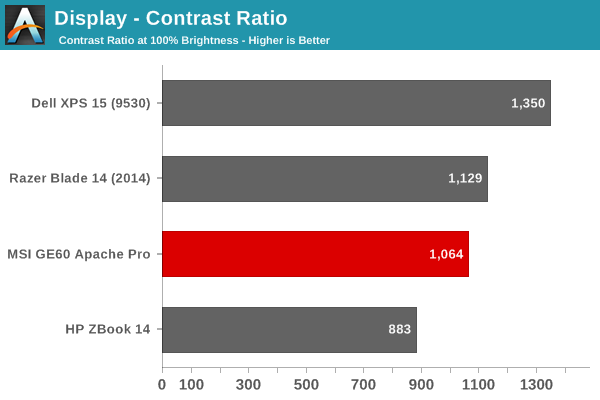
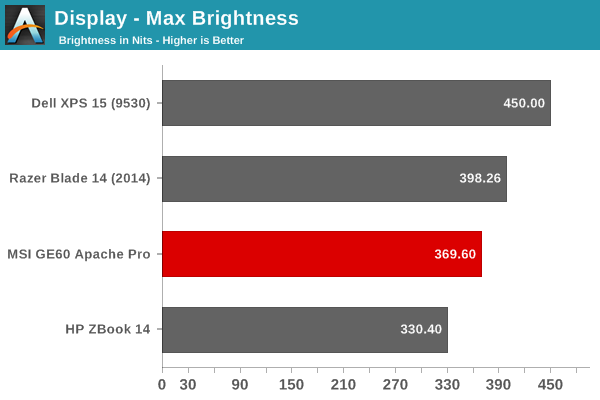
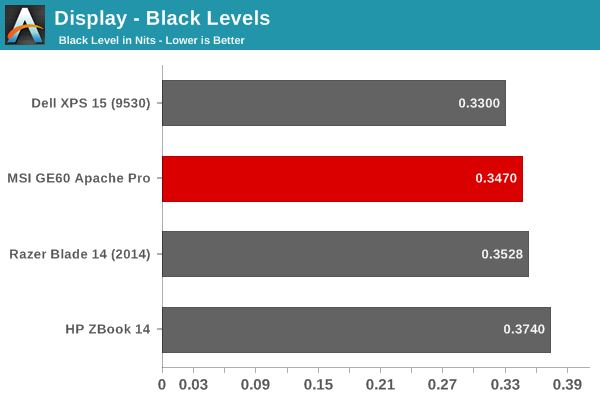
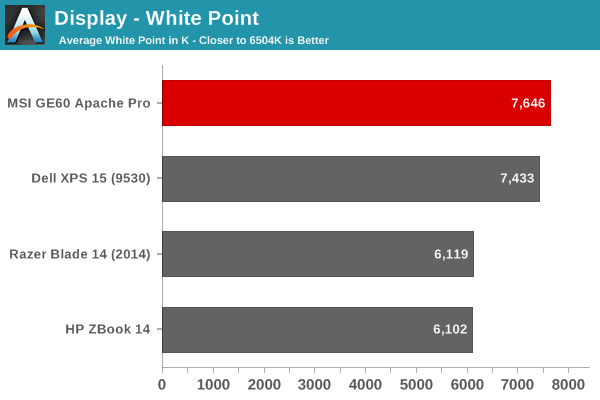
The white level of 370 cd/m2 is a good starting point, and with a black level of 0.3472 nits at max brightness we end up with a contrast ratio of 1064:1. That's not the best result that we've ever seen from a laptop, but it is quite good – even more so considering the display has an anti-glare coating (glossy displays tend to have a bit higher contrast). Dropping the brightness to 54% gives us a 200 nits white level with a 1016:1 contrast, so it's a bit lower but still good. The problem is the native white point is around 7650K, which is far from the "ideal" 6504K, so there's a definite blue tint to the colors. That brings us to the full uncalibrated results:

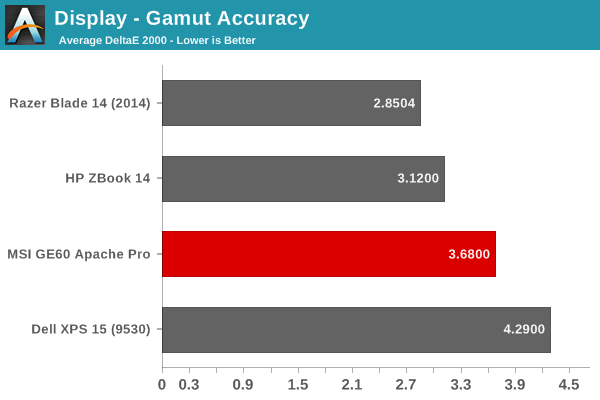


Grayscale results are good up until about 40%, at which point the errors start to become visible. By 50% the Delta E has increased to over 5, and by 75% dE is nearly 10. That's really not a very good result, though I've certainly seen worse (e.g. MSI's GT70 LCD had errors above 12 before calibration). Results in the other charts tell a similar story. While the average dE may only be in the range of 4.5 or so, there are many spikes into the high single digits – mostly in the reds, oranges, and yellows, but shades of green a blue also show some significant errors.
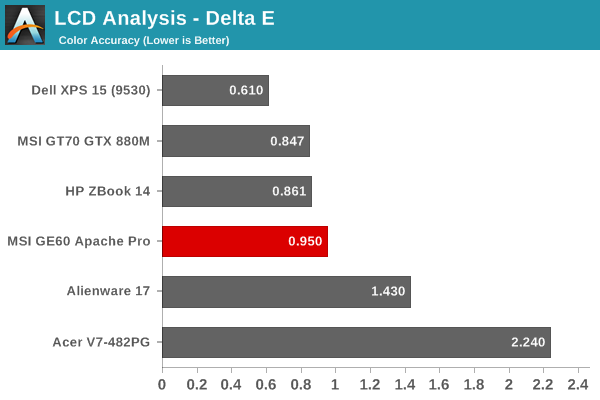
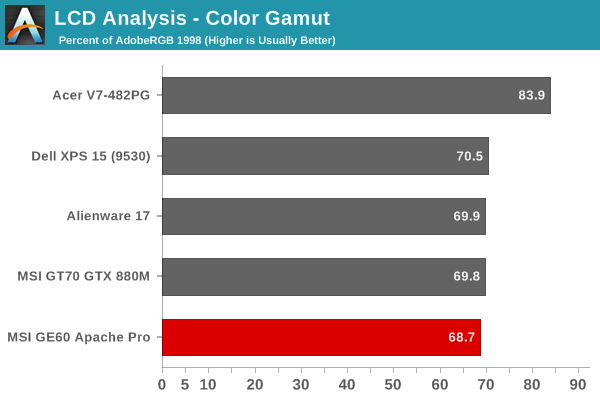
Post-calibration is a different story; the gamma, RGB balance, and color accuracy improve dramatically, to the point where there are very few errors even reaching 2.0. If you have the proper tools to calibrate the display, the GE60 can definitely suffice for professional work. The color gamut is also pretty close to the sRGB standard (it's 68.7% of AdobeRGB compared to a 72% target for sRGB), so outside of users who need high color depth it will work well.



























63 Comments
View All Comments
thesavvymage - Thursday, July 17, 2014 - link
in writing is not even always necessary, depending on local laws :) in Washington state, a verbal contract is a VALID contract. No need to write it and sign. There does need to be a third party to verify it thoughReedTFM - Friday, July 18, 2014 - link
For Americans, the Magnuson-Moss Warranty Act applies. Just modifying/servicing your product doesn't void a warranty guarantee, unless the producer can show the modification caused the defect. This came about because of car manufacturers were pulling crap like, "Oh look you added an aftermarket exhaust, you voided your warranty and we will not cover the windshield wipers failing."With static discharges, however, it will be hard to refute user error, but still, it's always worth making the argument.
ramj70 - Thursday, July 17, 2014 - link
I contacted MSI and they said that opening the laptop will to upgrade will not void the warranty. I also bought an SSD and replaced the HDDruthan - Thursday, July 17, 2014 - link
Without inbuild 3g modem.. so not for real life.Novaguy - Saturday, July 19, 2014 - link
There are phone plans that come with data tethering or wifi hotspot options, and I find those work well.Tanclearas - Thursday, July 17, 2014 - link
No DisplayPort and no G-Sync. This is exactly the class of machine that would benefit the most from it. Even if the claim is that it's too expensive to integrate into the laptop panel (though Nvidia themselves talked about how it's easier on laptops), DisplayPort would have at least allowed for the possibility of using an external G-Sync monitor.JarredWalton - Friday, July 18, 2014 - link
No, G-Sync is actually a pain in the butt on laptops, for one reason: Optimus. To do G-Sync, you need to have the GPU and display communicate with each other, so the only way NVIDIA can do it is if they get rid of Optimus. But doing that means you just killed battery life as well. There are potentially ways around that I'm sure, but it's the reason there haven't been any G-Sync notebooks yet. I actually asked NVIDIA about it at CES and they basically said as much: "We're looking at ways to implement it, but right now we don't have anything we can talk about."Tanclearas - Friday, July 18, 2014 - link
Wow. Interesting. Nvidia's response to AMD's "free sync" demo implied that laptops were easier to implement."However, Petersen quickly pointed out an important detail about AMD's "free sync" demo: it was conducted on laptop systems. Laptops, he explained, have a different display architecture than desktops, with a more direct interface between the GPU and the LCD panel, generally based on standards like LVDS or eDP (embedded DisplayPort). Desktop monitors use other interfaces, like HDMI and DisplayPort, and typically have a scaler chip situated in the path between the GPU and the panel. As a result, a feature like variable refresh is nearly impossible to implement on a desktop monitor as things now stand."
All of this just raises more questions.
In AMD's demo, did they have to disable DSG for free sync to work? If not, how does an AMD GPU communicate with the display? If so, then what AMD showed was even more impressive if Nvidia is still "looking at ways to implement it".
Are there laptops with free sync (officially) coming?
I am not trying to take things off topic. I just want to reiterate that the reviewed laptop is exactly the class of machine that would benefit the most from G-Sync/free sync. If anything, it is more important for a laptop because you do not ever have the option of replacing the GPU once your framerates start dropping.
One final (two-part) question. Could a laptop not have the DP connected directly to the Nvidia GPU? Is it not safe to assume that a person connected to an external DP monitor would have access to external power (and therefore not need Optimus)?
JarredWalton - Friday, July 18, 2014 - link
So basically on a laptop if you plug directly into the dGPU, yes, it's easier -- but I'm not sure how much easier we're really talking about. Obviously it can be done with desktop displays with enough effort, the main benefit of laptops being you have multiple inputs into desktop displays with scalers and such. An interesting corollary is that AMD might have an advantage with laptops using AMD APUs -- both the APU and dGPU would be AMD software, so there's no "Intel iGPU" in the way.As to the question of when laptops with G/Free Sync are coming, I don't believe any have been announced yet, so your guess is as good as mine. I told NVIDIA that laptops would be great for this as getting >60 FPS on a laptop is rather difficult but ~40 FPS with G-SYNC would still be achievable. We might see this in the next year, or perhaps even earlier with non-Optimus solutions (e.g. ASUS has the G750 without Optimus, so it might be a target for G-SYNC in an update). Of course, the number of displays with G-Sync support is still very small (one or two ASUS are officially available, another ASUS display can be modded by the user; Acer and BenQ have displays coming but they're not out yet.)
As for the second question: sure, an external G-Sync display could easily be driven by a laptop. But that sort of defeats the purpose of a laptop in large measure. :-)
Tanclearas - Saturday, July 19, 2014 - link
At first it might appear that it defeats the point of a laptop, but there is (what I assume a growing) group of aging gamers that require a laptop for business/work, but still want to game at home. I have a Lenovo Y580 with 16GB of RAM, a 240GB mSATA SSD, and the Nvidia GTX 660m. It's great for work, and OK for games, but would be better with G-Sync or free sync.